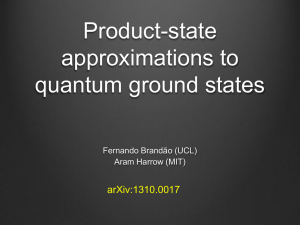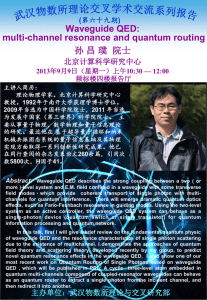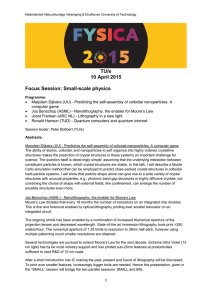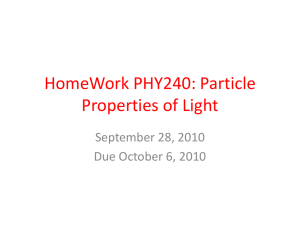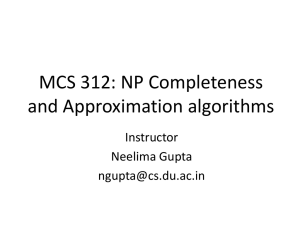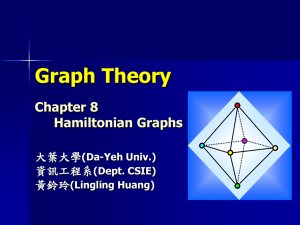Lecture 3: Quantum simulation algorithms
advertisement
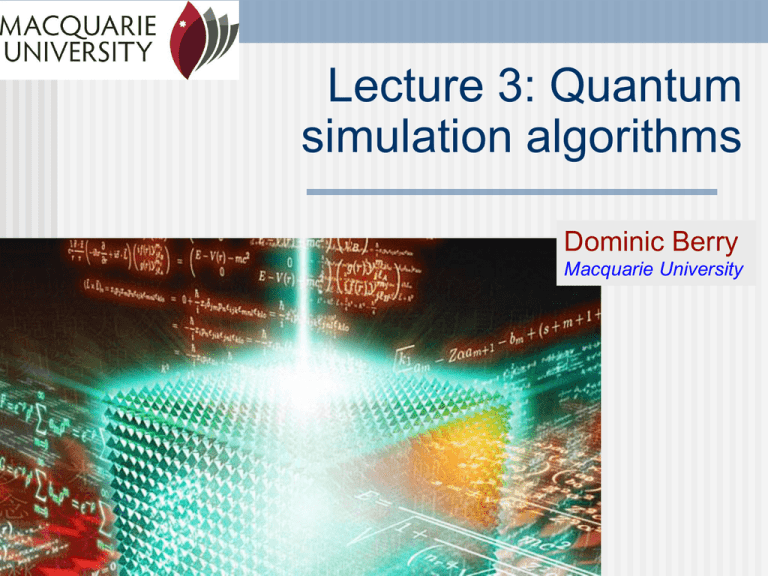
Lecture 3: Quantum simulation algorithms Dominic Berry Macquarie University 1996 Simulation of Hamiltonians We want to simulate the evolution 𝜓𝑡 = 𝑒 −𝑖𝐻𝑡 |𝜓0 ⟩ The Hamiltonian is a sum of terms: 𝑀 𝐻= 𝐻ℓ ℓ=1 Seth Lloyd We can perform 𝑒 −𝑖𝐻ℓ 𝑡 For short times we can use 𝑒 −𝑖𝐻1𝛿𝑡 𝑒 −𝑖𝐻2 𝛿𝑡 … 𝑒 −𝑖𝐻𝑀−1𝛿𝑡 𝑒 −𝑖𝐻𝑀 𝛿𝑡 ≈ 𝑒 −𝑖𝐻𝛿𝑡 For long times 𝑒 −𝑖𝐻1 𝑡/𝑟 𝑒 −𝑖𝐻2 𝑡/𝑟 … 𝑒 −𝑖𝐻𝑀 𝑡/𝑟 𝑟 ≈ 𝑒 −𝑖𝐻𝑡 Simulation of Hamiltonians 1996 For short times we can use 𝑒 −𝑖𝐻1𝛿𝑡 𝑒 −𝑖𝐻2 𝛿𝑡 … 𝑒 −𝑖𝐻𝑀−1𝛿𝑡 𝑒 −𝑖𝐻𝑀 𝛿𝑡 ≈ 𝑒 −𝑖𝐻𝛿𝑡 This approximation is because 𝑒 −𝑖𝐻1𝛿𝑡 𝑒 −𝑖𝐻2 𝛿𝑡 … 𝑒 −𝑖𝐻𝑀−1𝛿𝑡 𝑒 −𝑖𝐻𝑀 𝛿𝑡 = 𝕀 − 𝑖𝐻1 𝛿𝑡 + 𝑂 𝛿𝑡 2 𝕀 − 𝑖𝐻2 𝛿𝑡 + 𝑂 𝛿𝑡 2 … … 𝕀 − 𝑖𝐻𝑀 𝛿𝑡 + 𝑂 𝛿𝑡 2 Seth Lloyd = 𝕀 − 𝑖𝐻1 𝛿𝑡 − 𝑖𝐻2 𝛿𝑡 … − 𝑖𝐻𝑀 𝛿𝑡 + 𝑂 𝛿𝑡 2 = 𝕀 − 𝑖𝐻𝛿𝑡 + 𝑂 𝛿𝑡 2 = 𝑒 −𝑖𝐻𝛿𝑡 + 𝑂(𝛿𝑡 2 ) If we divide long time 𝑡 into 𝑟 intervals, then 𝑟 𝑟 𝑒 −𝑖𝐻𝑡 = 𝑒 −𝑖𝐻𝑡/𝑟 = 𝑒 −𝑖𝐻1 𝑡/𝑟 𝑒 −𝑖𝐻2𝑡/𝑟 … 𝑒 −𝑖𝐻𝑀 𝑡/𝑟 + 𝑂 𝑡/𝑟 2 𝑟 −𝑖𝐻 𝑡/𝑟 −𝑖𝐻 𝑡/𝑟 −𝑖𝐻 𝑡/𝑟 1 2 𝑀 = 𝑒 𝑒 …𝑒 + 𝑂 𝑡 2 /𝑟 Typically, we want to simulate a system with some maximum allowable error 𝜀. Then we need 𝑟 ∝ 𝑡 2 /𝜀. 2007 Higher-order simulation Berry, Ahokas, Cleve, Sanders A higher-order decomposition is 𝑒 −𝑖𝐻1 𝛿𝑡/2 … 𝑒 −𝑖𝐻𝑀−1𝛿𝑡/2 𝑒 −𝑖𝐻𝑀 𝛿𝑡/2 𝑒 −𝑖𝐻𝑀 𝛿𝑡/2 𝑒 −𝑖𝐻𝑀−1𝛿𝑡/2 … 𝑒 −𝑖𝐻1𝛿𝑡/2 = 𝑒 −𝑖𝐻𝛿𝑡 + 𝑂 𝑀 𝐻 𝛿𝑡 3 If we divide long time 𝑡 into 𝑟 intervals, then 𝑟 𝑒 −𝑖𝐻𝑡 = 𝑒 −𝑖𝐻𝑡/𝑟 𝑟 = 𝑒 −𝑖𝐻1 𝑡/2𝑟 … 𝑒 −𝑖𝐻𝑀 𝑡/2𝑟 𝑒 −𝑖𝐻𝑀 𝑡/2𝑟 … 𝑒 −𝑖𝐻1𝑡/2𝑟 + 𝑂 𝑀 𝐻 𝑡/𝑟 3 𝑟 = 𝑒 −𝑖𝐻1 𝑡/2𝑟 … 𝑒 −𝑖𝐻𝑀 𝑡/2𝑟 𝑒 −𝑖𝐻𝑀 𝑡/2𝑟 … 𝑒 −𝑖𝐻𝐾1𝑡/2𝑟 + 𝑂 𝑀 𝐻 𝑡 3 /𝑟 2 Then we need General product formula can give error 𝑂 𝑀 𝐻 𝑡/𝑟 For time 𝑡 the error is 𝑂 𝑀 𝐻 𝑡 To bound the error as 𝜀 the value of 𝑟 scales as 𝑀 𝐻 𝑡 1+1/2𝑘 𝑟∝ 𝜀 1/2𝑘 The complexity is 𝑟 × 𝑀. 1.5 / 𝑟∝ 𝑀 𝐻 𝑡 2𝑘+1 /𝑟 2𝑘 . 𝜀. 2𝑘+1 for time 𝑡/𝑟. Higher-order simulation 2007 Berry, Ahokas, Cleve, Sanders 𝑀 𝐻 𝑡 1+1/2𝑘 𝑟∝ 𝜀 1/2𝑘 The complexity is 𝑟 × 𝑀. For Sukuki product formulae, we have an additional factor in 𝑟 5𝑘 𝑀 𝐻 𝑡 1+1/2𝑘 𝑟∝ 𝜀 1/2𝑘 The complexity then needs to be multiplied by a further factor of 5𝑘 . The overall complexity scales as 𝑀52𝑘 𝑀 𝐻 𝑡 1+1/2𝑘 𝜀 1/2𝑘 We can also take an optimal value of 𝑘 ∝ log 𝑀 𝐻 𝑡/𝜀 , which gives scaling 𝑀2 𝐻 𝑡 exp[2 ln 5 ln(𝑀 𝐻 𝑡/𝜀)] Solving linear systems Consider a large system of linear equations: 𝐴𝒙 = 𝒚 First assume that the matrix 𝐴 is Hermitian. It is possible to simulate Hamiltonian evolution under 𝐴 for time 𝑡: 𝑒 −𝑖𝐴𝑡 . Encode the initial state in the form 2009 𝑁 𝒚 = 𝑦ℓ |ℓ⟩ ℓ=1 The state can also be written in terms of the eigenvectors of 𝐴 as 𝑁 𝒚 = 𝜓𝑘 |𝜆𝑘 ⟩ 𝑘=1 We can obtain the solution |𝒙⟩ if we can divide each 𝜓𝑘 by 𝜆𝑘 . Use the phase estimation technique to place the estimate of 𝜆𝑘 in an ancillary register to obtain 𝑁 𝜓𝑘 |𝜆𝑘 ⟩|𝜆𝑘 ⟩ 𝑘=1 Harrow, Hassidim & Lloyd Solving linear systems 2009 Use the phase estimation technique to place the estimate of 𝜆𝑘 in an ancillary register to obtain 𝑁 𝜓𝑘 |𝜆𝑘 ⟩|𝜆𝑘 ⟩ 𝑘=1 Append an ancilla and rotate it according to the value of 𝜆𝑘 to obtain 𝑁 𝜓𝑘 |𝜆𝑘 ⟩|𝜆𝑘 ⟩ 𝑘=1 Invert the phase estimation technique to remove the estimate of 𝜆𝑘 from the ancillary register, giving 𝑁 𝑘=1 1 1 0 + 1 − 2 |1⟩ 𝜆𝑘 𝜆𝑘 1 1 𝜓𝑘 |𝜆𝑘 ⟩ 0 + 1 − 2 |1⟩ 𝜆𝑘 𝜆𝑘 Use amplitude amplification to amplify the |0⟩ component on the ancilla, giving a state proportional to 𝑁 𝒙 ∝ 𝑘=1 𝜓𝑘 |𝜆 ⟩ = 𝜆𝑘 𝑘 𝑁 𝑥ℓ |ℓ⟩ ℓ=1 Harrow, Hassidim & Lloyd Solving linear systems What about non-Hermitian 𝐴? Construct a blockwise matrix 0 𝐴 𝐴′ = † 𝐴 0 The inverse of 𝐴′ is then 𝐴′ −1 = 0 𝐴−1 This means that 0 𝐴−1 −1 𝐴† 0 𝐴† 0 −1 𝒚 0 = 0 𝒙 In terms of the state |0⟩|𝒚⟩ ↦ |1⟩|𝒙⟩ 2009 Harrow, Hassidim & Lloyd Solving linear systems 2009 Complexity Analysis We need to examine: 1. The complexity of simulating the Hamiltonian to estimate the phase. 2. The accuracy needed for the phase estimate. 3. The possibility of 1/𝜆𝑘 being greater than 1. The complexity of simulating the Hamiltonian for time 𝑡 is approximately ∝ 𝐴 𝑡 = |𝜆max |𝑡. To obtain accuracy 𝛿 in the estimate of 𝜆, the Hamiltonian needs to be simulated for time ∝ 1/𝛿. We actually need to multiply the state coefficients by 𝜆min /𝜆𝑘 , to give 𝑁 𝑘=1 |𝜆min | 𝜓𝑘 |𝜆𝑘 ⟩ 𝜆𝑘 To obtain accuracy 𝜀 in 𝜆min /𝜆𝑘 , we need accuracy 𝜀𝜆2𝑘 / 𝜆min in the estimate of 𝜆. Harrow, Hassidim & Lloyd Final complexity is 𝜅2 |𝜆max | ∼ , 𝜅: = 𝜀 |𝜆min | 2010 Differential equations Berry Discretise the differential equation, then encode as a linear system. Simplest discretisation: Euler method. dx Ax b dt sets initial condition x j 1 x j I 0 0 ( I Ah) I 0 0 ( I Ah) I 0 0 I 0 0 0 sets x to be constant h 0 0 0 I I Ax j b 0 x 0 xin 0 x1 bh 0 x 2 bh 0 x3 0 I x 4 0 Quantum walks The quantum walk has position and coin values |𝑥, 𝑐⟩ It then alternates coin and step operators, e.g. 𝐶 𝑥, ±1 = 𝑥, −1 ± 𝑥, 1 / 2 𝑆 𝑥, 𝑐 = |𝑥 + 𝑐, 𝑐⟩ The position can progress linearly in the number of steps. A classical walk has a position which is an integer, 𝑥, which jumps either to the left or the right at each step. The resulting distribution is a binomial distribution, or a normal distribution as the limit. Quantum walk on a graph The walk position is any node on the graph. Describe the generator matrix 𝐾 by 𝛾, 𝑎 ≠ 𝑎′ , 𝑎𝑎′ ∈ 𝐺 0, 𝐾𝑎𝑎′ = 𝑎 ≠ 𝑎′ , 𝑎𝑎′ ∉ 𝐺 −𝑑 𝑎 𝛾, 𝑎 = 𝑎′ The quantity 𝑑(𝑎) is the number of edges incident on vertex 𝑎. An edge between 𝑎 and 𝑎 ′ is denoted 𝑎𝑎′ . The probability distribution for a continuous walk has the differential equation 𝑑𝑝𝑎 𝑡 = 𝐾𝑎𝑎′ 𝑝𝑎′ (𝑡) 𝑑𝑡 ′ 𝑎 1998 Quantum walk on a graph 𝑑𝑝𝑎 𝑡 = 𝑑𝑡 Farhi 𝐾𝑎𝑎′ 𝑝𝑎′ (𝑡) 𝑎′ Quantum mechanically we have 𝑑 𝑖 𝜓 𝑡 = 𝐻|𝜓 𝑡 ⟩ 𝑑𝑡 𝑑 𝑖 ⟨𝑎 𝜓 𝑡 = 𝑎 𝐻 𝑎′ ⟨𝑎′|𝜓 𝑡 ⟩ 𝑑𝑡 ′ 𝑎 The natural quantum analogue is 𝑎 𝐻 𝑎′ = 𝐾𝑎𝑎′ We take 𝑎𝐻 𝑎′ 𝛾, = 0, 𝑎 ≠ 𝑎′ , 𝑎𝑎′ ∈ 𝐺 otherwise. Probability is conserved because 𝐻 is Hermitian. Quantum walk on a graph entrance Childs, Farhi, Gutmann The goal is to traverse the graph from entrance to exit. Classically the random walk will take exponential time. For the quantum walk, define a superposition state 1 col 𝑗 = |𝑎⟩ 𝑁𝑗 𝑎∈column 𝑗 exit 𝑁𝑗 = 2002 2𝑗 22𝑛+1−𝑗 0≤𝑗≤𝑛 𝑛 + 1 ≤ 𝑗 ≤ 2𝑛 + 1 On these states the matrix elements of the Hamiltonian are col 𝑗 𝐻 col 𝑗 ± 1 = 2𝛾 Quantum walk on a graph entrance 2003 Childs, Cleve, Deotto, Farhi, Gutmann, Spielman Add random connections between the two trees. All vertices (except entrance and exit) have degree 3. Again using column states, the matrix elements of the Hamiltonian are exit col 𝑗 𝐻 col 𝑗 ± 1 = 2𝛾 2𝛾 𝑗≠𝑛 𝑗=𝑛 This is a line with a defect. There are reflections off the defect, but the quantum walk still reaches the exit efficiently. 2007 NAND tree quantum walk Farhi, Goldstone, Gutmann In a game tree I alternate making moves with an opponent. In this example, if I move first then I can always direct the ant to the sugar cube. What is the complexity of doing this in general? Do we need to query all the leaves? AND OR AND 𝑥1 OR AND AND 𝑥2 𝑥3 𝑥4 𝑥5 AND 𝑥6 𝑥7 𝑥8 2007 NAND tree quantum walk OR OR AND 𝑥1 NOT AND 𝑥2 𝑥3 NOT AND 𝑥4 𝑥1 NAND NAND 𝑥1 Farhi, Goldstone, Gutmann NAND 𝑥2 𝑥3 𝑥4 NOT NOT AND 𝑥2 𝑥3 𝑥4 NAND tree quantum walk 2007 Farhi, Goldstone, Gutmann wave The Hamiltonian is a sum of an oracle Hamiltonian, representing the connections, and a fixed driving Hamiltonian, which is the remainder of the tree. 𝐻 = 𝐻𝑂 + 𝐻𝐷 Prepare a travelling wave packet on the left. If the answer to the NAND tree problem is 1, then after a fixed time the wave packet will be found on the right. The reflection depends on the solution of the NAND tree problem. Simulating quantum walks A more realistic scenario is that we have an oracle that provides the structure of the graph; i.e., a query to a node returns all the nodes that are connected. The quantum oracle is queried with a node number 𝑥 and a neighbour number 𝑗. It returns a result via the quantum operation 𝑈𝑂 𝑥, 𝑗 |0⟩ = 𝑥, 𝑗 |𝑦⟩ wave Here 𝑦 is the 𝑗’th neighbour of 𝑥. |𝑥, 𝑗⟩ 𝑈𝑂 |0⟩ connected nodes query node |𝑥, 𝑗⟩ |𝑦⟩ Decomposing the Hamiltonian 0 0 1 The rows and columns correspond to 0 node numbers. 𝐻= 0 The ones indicate connections 1 between nodes. ⋮ The oracle gives us the position of 0 In the matrix picture, we have a sparse matrix. the 𝑗’th nonzero element in column 𝑥. 0 1 0 0 0 1 ⋮ 0 1 0 0 0 0 0 ⋮ 1 0 0 0 1 1 0 ⋮ 0 0 0 0 1 1 0 ⋮ 0 1 1 0 0 0 0 ⋮ 0 2003 Aharonov, Ta-Shma ⋯ ⋯ ⋯ ⋯ ⋯ ⋯ ⋱ ⋯ 0 0 1 0 0 0 ⋮ 1 Decomposing the Hamiltonian 0 0 1 The rows and columns correspond to 0 node numbers. 𝐻= 0 The ones indicate connections 1 between nodes. ⋮ The oracle gives us the position of 0 In the matrix picture, we have a sparse matrix. the 𝑗’th nonzero element in column 𝑥. We want to be able to separate the Hamiltonian into 1-sparse parts. This is equivalent to a graph colouring – the graph edges are coloured such that each node has unique colours. 0 1 0 0 0 1 ⋮ 0 1 0 0 0 0 0 ⋮ 1 0 0 0 1 1 0 ⋮ 0 0 0 0 1 1 0 ⋮ 0 1 1 0 0 0 0 ⋮ 0 2003 Aharonov, Ta-Shma ⋯ ⋯ ⋯ ⋯ ⋯ ⋯ ⋱ ⋯ 0 0 1 0 0 0 ⋮ 1 2007 Graph colouring 0 0 First guess: for each node, assign 1 edges sequentially according to their 0 numbering. 𝐻= 0 This does not work because the edge 1 between nodes 𝑥 and 𝑦 may be edge ⋮ 1 (for example) of 𝑥, but edge 2 of 𝑦. 0 How do we do this colouring? Second guess: for edge between 𝑥 and 𝑦, colour it according to the pair of numbers (𝑗𝑥 , 𝑗𝑦 ), where it is edge 𝑗𝑥 of node 𝑥 and edge 𝑗𝑦 of node 𝑦. We decide the order such that 𝑥 < 𝑦. It is still possible to have ambiguity: say we have 𝑥 < 𝑦 < 𝑧. Berry, Ahokas, Cleve, Sanders 0 1 0 0 0 1 ⋮ 0 1 0 0 0 0 0 ⋮ 1 0 0 0 1 1 0 ⋮ 0 0 0 0 1 1 0 ⋮ 0 1 1 0 0 0 0 ⋮ 0 ⋯ ⋯ ⋯ ⋯ ⋯ ⋯ ⋱ ⋯ 0 0 1 0 0 0 ⋮ 1 2007 Graph colouring Berry, Ahokas, Cleve, Sanders 0 0 First guess: for each node, assign 1 edges sequentially according to their 0 numbering. 𝐻= 0 This does not work because the edge 1 between nodes 𝑥 and 𝑦 may be edge ⋮ 1 (for example) of 𝑥, but edge 2 of 𝑦. 0 How do we do this colouring? Second guess: for edge between 𝑥 and 𝑦, colour it according to the pair of numbers (𝑗𝑥 , 𝑗𝑦 ), where it is edge 𝑗𝑥 of node 𝑥 and edge 𝑗𝑦 of node 𝑦. We decide the order such that 𝑥 < 𝑦. It is still possible to have ambiguity: say we have 𝑥 < 𝑦 < 𝑧. 0 1 0 0 0 1 ⋮ 0 𝑥 3 1 0 0 0 0 0 ⋮ 1 0 0 0 1 1 0 ⋮ 0 0 0 0 1 1 0 ⋮ 0 1 1 0 0 0 0 ⋮ 0 0 0 1 0 0 0 ⋮ 1 2 1 (1,2) 3 2 𝑦(1,2) 1 2 3 ⋯ ⋯ ⋯ ⋯ ⋯ ⋯ ⋱ ⋯ 𝑧 1 Use a string of nodes with equal edge colours, and compress. General Hamiltonian oracles 0 0 2 0 𝐻= 0 − 2𝑖 ⋮ 0 0 3 0 0 0 1/2 ⋮ 0 − 2 0 0 0 0 0 0 0 0 0 ⋮ 3−𝑖 0 1 0 𝑒 −𝑖𝜋/7 0 ⋮ 0 More generally, we can perform a colouring on a graph with matrix elements of arbitrary (Hermitian) values. Then we also require an oracle to give us the values of the matrix elements. 𝑒 𝑖𝜋/7 2 0 ⋮ 0 |𝑥, 𝑗⟩ |0⟩ |𝑥, 𝑦⟩ |0⟩ 2𝑖 ⋯ 1/2 ⋯ 0 0 0 0 ⋮ 0 2003 Aharonov, Ta-Shma 0 0 ⋯ − 3+𝑖 ⋯ 0 ⋯ 0 ⋯ 0 ⋱ ⋮ ⋯ 1/10 𝑈𝑂 𝑈𝐻 |𝑥, 𝑗⟩ |𝑦⟩ |𝑥, 𝑦⟩ |𝐻𝑥,𝑦 ⟩ Simulating 1-sparse case 0 0 0 0 𝐻= 0 − 2𝑖 ⋮ 0 0 3 0 0 0 0 ⋮ 0 0 0 0 0 0 0 ⋮ − 3−𝑖 0 0 0 1 0 0 ⋮ 0 0 0 0 0 2 0 ⋮ 0 2𝑖 0 0 0 0 0 ⋮ 0 2003 Aharonov, Ta-Shma ⋯ 0 ⋯ 0 ⋯ − 3+𝑖 ⋯ 0 ⋯ 0 ⋯ 0 ⋱ ⋮ ⋯ 0 Assume we have a 1-sparse matrix. How can we simulate evolution under this Hamiltonian? Two cases: 1. If the element is on the diagonal, then we have a 1D subspace. 2. If the element is off the diagonal, then we need a 2D subspace. Simulating 1-sparse case 2003 Aharonov, Ta-Shma We are given a column number 𝑥. There are then 5 quantities that we want to calculate: 1. 𝑏𝑥 : A bit registering whether the element is on or off the diagonal; i.e. 𝑥 belongs to a 1D or 2D subspace. 2. 𝑚𝑖𝑛𝑥 : The minimum number out of the (1D or 2D) subspace to which 𝑥 belongs. 3. 𝑚𝑎𝑥𝑥 : The maximum number out of the subspace to which 𝑥 belongs. 4. 𝐴𝑥 : The entries of 𝐻 in the subspace to which 𝑥 belongs. 5. 𝑈𝑥 : The evolution under 𝐻 for time 𝑡 in the subspace. We have a unitary operation that maps 𝑥 0 → 𝑥 |𝑏𝑥 , 𝑚𝑖𝑛𝑥 , 𝑚𝑎𝑥𝑥 , 𝐴𝑥 , 𝑈𝑥 ⟩ Simulating 1-sparse case 2003 Aharonov, Ta-Shma We have a unitary operation that maps 𝑥 0 → 𝑥 |𝑏𝑥 , 𝑚𝑖𝑛𝑥 , 𝑚𝑎𝑥𝑥 , 𝐴𝑥 , 𝑈𝑥 ⟩ We consider a superposition of the two states in the subspace, 𝜓 = 𝜇 𝑚𝑖𝑛𝑥 + 𝜈 𝑚𝑎𝑥𝑥 Then we obtain 𝜓 |0⟩ → |𝜓⟩|𝑏𝑥 , 𝑚𝑖𝑛𝑥 , 𝑚𝑎𝑥𝑥 , 𝐴𝑥 , 𝑈𝑥 ⟩ A second operation implements the controlled operation based on the stored approximation of the unitary operation 𝑈𝑥 : |𝜓⟩ 𝑈𝑥 , 𝑚𝑖𝑛𝑥 , 𝑚𝑎𝑥𝑥 → 𝑈𝑥 |𝜓⟩ 𝑈𝑥 , 𝑚𝑖𝑛𝑥 , 𝑚𝑎𝑥𝑥 This gives us 𝑈𝑥 |𝜓⟩|𝑏𝑥 , 𝑚𝑖𝑛𝑥 , 𝑚𝑎𝑥𝑥 , 𝐴𝑥 , 𝑈𝑥 ⟩ Inverting the first operation then yields 𝑈𝑥 𝜓 0 Applications 2007: Discrete query NAND algorithm – Childs, Cleve, Jordan, Yeung 2009: Solving linear systems – Harrow, Hassidim, Lloyd 2009: Implementing sparse unitaries – Jordan, Wocjan 2010: Solving linear differential equations – Berry 2013: Algorithm for scattering cross section – Clader, Jacobs, Sprouse Implementing unitaries 2009 Jordan, Wocjan Construct a Hamiltonian from unitary as 0 𝐻= † 𝑈 𝑈 0 Now simulate evolution under this Hamiltonian 𝑒 −𝑖𝐻𝑡 = 𝕀 cos 𝑡 − 𝑖𝐻 sin 𝑡 Simulating for time 𝑡 = 𝜋/2 gives 𝑒 −𝑖𝐻𝜋/2 1 𝜓 = −𝑖𝐻 1 𝜓 = −𝑖|0⟩𝑈|𝜓⟩ Quantum simulation via walks Three ingredients: 1. A Szegedy quantum walk 2. Coherent phase estimation 3. Controlled state preparation The quantum walk has eigenvalues and eigenvectors related to those for Hamiltonian. By using phase estimation, we can estimate the eigenvalue, then implement that actually needed. Szegedy Quantum Walk 2004 Szegedy The walk uses two reflections 2𝐶𝐶 † − 𝕀 2𝑅𝑅† − 𝕀 The first is controlled by the first register and acts on the second register. Given some matrix 𝑐[𝑖, 𝑗], the operator 𝐶 is defined by 𝑁 𝑐𝑖 = 𝑐[𝑖, 𝑗]|𝑗⟩ 𝑗=1 𝑁 𝐶= 𝑖 ⟨𝑖| ⊗ |𝑐𝑖 ⟩ 𝑖=1 Szegedy Quantum Walk 2004 Szegedy The diffusion operator 2𝑅𝑅† − 𝕀 is controlled by the second register and acts on the first. Use a similar definition with matrix 𝑟[𝑖, 𝑗]. Both are controlled reflections: 𝑁 2𝐶𝐶 † − 𝕀 = 𝑖 ⟨𝑖| ⊗ (2|𝑐𝑖 ⟩⟨𝑐𝑖 | − 𝕀) 𝑖=1 𝑁 2𝑅𝑅† − 𝕀 = (2|𝑟𝑖 ⟩⟨𝑟𝑖 | − 𝕀) ⊗ 𝑖 ⟨𝑖| 𝑖=1 The eigenvalues and eigenvectors of the step of the quantum walk (2𝐶𝐶 † − 𝕀)(2𝑅𝑅† − 𝕀) are related to those of a matrix formed from 𝑐[𝑖, 𝑗] and 𝑟[𝑖, 𝑗]. 2012 Szegedy walk for simulation Berry, Childs Use symmetric system, with ∗ 𝑐 𝑖, 𝑗 = 𝑟 𝑖, 𝑗 = 𝐻𝑖𝑗 Then eigenvalues and eigenvectors are related to those of Hamiltonian. In reality we need to modify to “lazy” quantum walk, with 𝑐𝑖 = 𝛿 𝐻 𝑁 1 ∗ 𝐻𝑖𝑗 |𝑗⟩ 𝑗=1 𝜎𝑖 𝛿 + 1− |𝑁 + 1⟩ 𝐻 1 𝑁 𝜎𝑖 ≔ Grover preparation gives 𝜓𝑏 = 1 𝑁 𝑁 𝑘=1 𝑘 𝜓𝑘 0 + 1 − 𝜓𝑘 2 |1⟩ |𝐻𝑖𝑗 | 𝑗=1 Szegedy walk for simulation 2012 Berry, Childs Three step process: 1. Start with state in one of the subsystems, and perform controlled state preparation. 2. Perform steps of quantum walk to approximate Hamiltonian evolution. 3. Invert controlled state preparation, so final state is in one of the subsystems. Step 2 can just be performed with small 𝛿 for lazy quantum walk, or can use phase estimation. A Hamiltonian has eigenvalues 𝜇, so evolution under the Hamiltonian has eigenvalues 𝑒 −𝑖𝜇𝑇 𝑉 is the step of a quantum walk, and has eigenvalues 𝑒 𝑖𝜆 = ±𝑒 ±𝑖 arcsin 𝜇𝛿 The complexity is the maximum of 𝐻 𝑇 𝑑 𝐻 max 𝑇 𝜀




